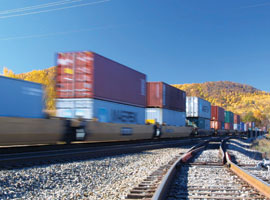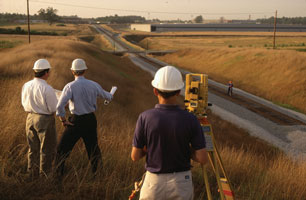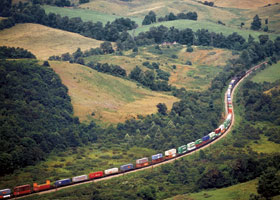It’s one of America's oldest industries. And one of its most modern.
It helped build this nation by opening up vast interior regions to settlement, agriculture and manufacturing.
Then it underwent a long period when its future was in doubt, as government policies favored its competitors.
And now it stands poised to enter a new era of growth as America’s policy makers increasingly realize that this industry holds the key to a growing economy as well as an ability to reduce pollution and energy consumption.
This is railroading in the 21st century.
 The history of America’s railroads is one of achievement. Prior to the railroad, settlement was largely limited to areas along the east coast and along navigable waterways. But the railroad changed all that, opening vast interior lands to settlement, agriculture and manufacturing by providing inexpensive and efficient transportation over long distances.
The history of America’s railroads is one of achievement. Prior to the railroad, settlement was largely limited to areas along the east coast and along navigable waterways. But the railroad changed all that, opening vast interior lands to settlement, agriculture and manufacturing by providing inexpensive and efficient transportation over long distances.
But as other modes of transportation developed in the early to mid-twentieth century, railroads entered a long period of decline, especially in the years after World War II when the government provided generous subsidies to highways and aviation while at the same time an antiquated regulatory system prevented railroads from responding to market forces. By the end of the 1970s, more than 20 percent of railroads were bankrupt.
In a last ditch attempt to save the private rail network, in 1980 Congress passed and President Jimmy Carter signed the Staggers Rail Act which introduced a balanced regulatory system that permitted railroads to rely more on market forces. The results have been impressive.
Today, America’s freight rail system provides the world’s most efficient, cost-effective freight rail service. It is vital to the economic health of the American economy and keeps U.S. companies competitive in world markets by moving freight at rates that average less than half that of other major world rail systems. It is also the safest, most environmentally friendly and energy efficient mode of surface transportation, providing in excess of 40 percent of the nation’s freight transportation, more than any other mode.
Railroads accomplished these achievements both by working individually and by working collectively, especially through the Association of American Railroads (AAR), North America’s largest railway trade association.
The AAR was founded in 1934 at the behest of President Franklin Roosevelt who believed that a unified rail system could help promote economic progress that would end the Great Depression.
Today, the AAR is recognized around the world for its efforts to improve the efficiency and safety of freight railroads. Helping keep the industry stay on the cutting edge of information technology is a wholly-owned subsidiary, Railinc of Cary, N.C. Another wholly-owned AAR subsidiary, the Transportation Technology Center Inc. of Pueblo, Colo., is generally regarded as the most advanced freight rail research and testing facility in the world. The efforts of these two subsidiaries have helped railroads almost triple productivity since 1980 and reduce fuel consumption by half.
 AAR members include most of the major freight railroads in the U.S., Canada and Mexico, as well as Amtrak, some commuter railroads and numerous short-line freight railroads. In addition, almost 100 railroad suppliers are associate members.
AAR members include most of the major freight railroads in the U.S., Canada and Mexico, as well as Amtrak, some commuter railroads and numerous short-line freight railroads. In addition, almost 100 railroad suppliers are associate members.
The strong foundation established over the past 30 years is especially important today as railroads are being called upon to do even more. One piece of legislation proposed in Congress sets a national goal of diverting 10 percent of all highway freight to the rails. At the same time, railroads are also being asked to open their networks to more and faster passenger trains.
It’s easy to see why policy makers like rail. It’s fuel efficient; it’s environmentally sound; and it’s economical.
Last year, freight trains moved a ton of freight an average of 480 miles on a single gallon of diesel fuel, almost four times as far as it could move on the highway. If just 10 percent of the long distance freight moving be highway went instead by train, the nation could save over one billion gallons of fuel annually.
Rail is also good for the environment. Moving a ton of freight by rail reduces greenhouse gases by two-thirds in comparison with moving it by highway. A third benefit comes from reducing highway congestion. A single intermodal train can carry the equivalent of 280 trucks over long distances.
But one critical fact about today’s railroads is largely unknown: unlike all other modes of transportation, railroads operate over infrastructure that they build and maintain with virtually no taxpayer help. Since 1980, railroads have invested more than $460 billion – more than 40 cents out of every revenue dollar – of their own private capital to maintain, renew and expand the nation’s rail network infrastructure that serves both passenger and freight rail traffic.
Before the economic slowdown began in 2008, the rail network was facing congestion and the need to increase capacity to handle an expected doubling of volume over 25 years. Add to that the new call by the Obama Administration for increased commuter and high-speed rail passenger service, much of which will have to run over freight rail lines, and it becomes obvious that 21st century transportation needs will rely heavily on freight rail’s ability to meet America’s expectations.
 With railroads being called upon to do more, it becomes even more critical that railroads continue to be able to attract the capital needed to build and sustain the nation’s rail network infrastructure. One bipartisan measure proposed in both the House and Senate would provide a 25 percent tax incentive for any investment made to increase freight rail capacity. That incentive would be available to any entity – railroad, rail customer or local community – that makes an investment to increase rail capacity. For example, a trucking company might invest in an intermodal terminal or a rail customer might invest in a rail spur to their facility in order to connect to the national freight network.
With railroads being called upon to do more, it becomes even more critical that railroads continue to be able to attract the capital needed to build and sustain the nation’s rail network infrastructure. One bipartisan measure proposed in both the House and Senate would provide a 25 percent tax incentive for any investment made to increase freight rail capacity. That incentive would be available to any entity – railroad, rail customer or local community – that makes an investment to increase rail capacity. For example, a trucking company might invest in an intermodal terminal or a rail customer might invest in a rail spur to their facility in order to connect to the national freight network.
Because of the substantial and easily quantifiable public benefits, there also exists a compelling case for public-private partnerships that include freight rail expansion.
A prime example of this is the Chicago Region Environmental and Transportation Efficiency (CREATE) project in Chicago aimed at: reducing greenhouse gases and lowering wait time at grade crossings; improving emergency response times; adding passenger capacity and improving passenger reliability; and improving overall surface mobility in the region.
Our nation’s history shows that efficient transportation brings with it long-term economic prosperity. Investment in railroad infrastructure is one of the best investments our nation can make.
America's railroads stand ready, willing and able to help the nation achieve its 21st century priorities. Today, railroads are a shining American success story – a great example of success that can result when the right balance is struck between government regulation and private innovation.

